Table of Contents

Are you looking for a way to add an extra layer of flavor to your meals? Look no further than tarragon!
This versatile herb is chock full of flavor and can be used in a variety of dishes.
In this blog post, we‘ll explore the different ways to use tarragon, as well as some of the health benefits associated with this powerhouse herb.
So get ready to experience the deliciousness that is tarragon!
Tarragon: historical overview
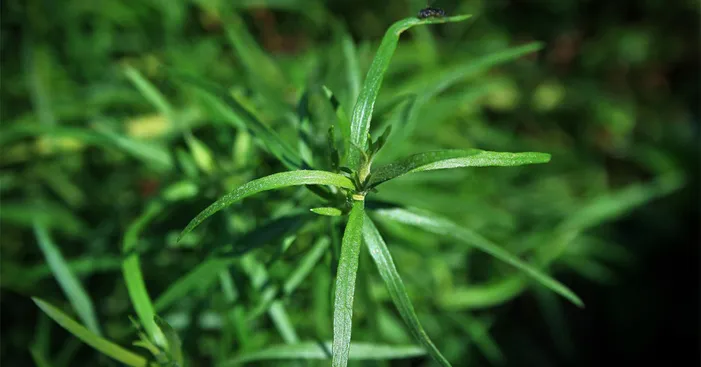
This herb goes by the scientific name Artemisia Dracunculus which is native to North America and Eastern Europe.
Tarragon is among the Daisy family species which makes it a close relative to sunflowers, sage, and chamomile.
It is an aromatic plant very famous for its unique acidic and spicy flavor which enhances the flavor of any recipe.
There are two common varieties of this plant, the Russian variety with a mild fragrance and the French variety with a pronounced fragrance.
Some people call it a little dragon as it was long believed that tarragon can cure people of venomous animals.
Other people speculate that the name “little dragon” could be inspired by the shape of the leaves as they look like flames.
However, this herb is native to Eastern Europe in sunny regions and can reach up to 3 ft in height (1 meter).
The Russian variety was appreciated by the Arabs who brought it back and introduced it to the Mediterranean trades.
For instance, it is said that this plant reached Italy right after the crusades where it got diffused across the country.
Nonetheless, other people believe that it reached the Tuscany region of Italy around 774.
Later on, in the 16th century, it was mentioned by the famous Italian chef Cristoforo da Messisbugo in a number of his books.
This herb was used to accompany boiled meat, chicken, salads, and different types of sauces and seasoning techniques.
Nowadays, tarragon started disappearing as we don’t see it in traditional preparations like the Old Siena sauce.
It was in the 19th century when people in the US started cultivating tarragon and since then it has been used in most recipes.
Types of tarragon:
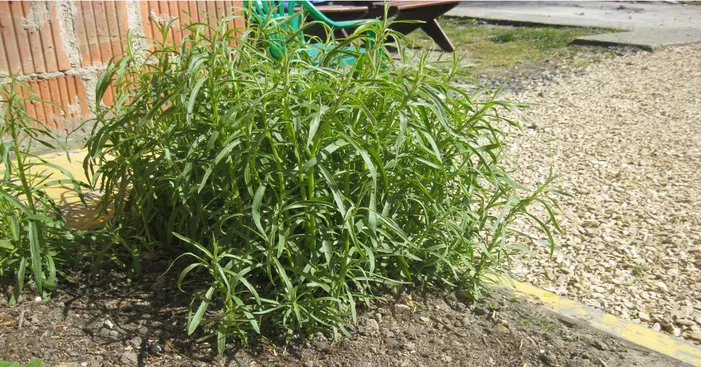
The Russian tarragon:
This variety goes by the scientific name Artemisia Dracunculus Dracunculoides and it differs from the French variety.
For instance, this plant lives longer than the French types and reaches a height of 5 ft (1.5m), and is available almost all year around.
Because of that, whenever you find tarragon seed in the market they most likely contain the Russian variety.
The Russian type has a weaker taste which explains why it is not very often used for culinary purposes.
The French tarragon:
This is the type that made this herb very famous especially since it made its way into many French recipes.
In fact, French tarragon is one of the 4 most used herbs in French cuisine alongside parsley, Chervil, and Chives.
The plant of this variety does not exceed 2.5 ft (0.8m) in height and produces sterile seeds.
However, the seedlings of this type have little to no taste which makes them the primary way of multiplying this plant.
Botanically, this type is the result of the mutation of wild tarragon which was found in Italy more than 6 centuries ago.
People praise French tarragon because of its unique intense flavor which is perfect for poultry seasoning, Béarnaise sauce, and cheese.
The difference between French and Russian tarragon:
Nowadays, most people supposed that the label on a product is enough to know which one we should buy.
This is not the case for tarragon because you are most likely not going to find the type of tarragon on the label.
In most cases when you find the label “Tarragon” by itself, it is most likely talking about the Russian type.
Here’s what differs them:
- Russian tarragon has light green leaves.
- French tarragon produces dark green leaves.
However, sometimes it is not easy to tell the difference in color especially if you don’t have them side by side.
Some people like to rely on the taste since the French variety has a very pronounced flavor while the Russian type has almost no taste.
Nutritional values and health benefits of tarragon:

Nutritional value:
The first good thing about this herb is the fact that it contains almost no calories as 2 tbsp of fresh tarragon only has 20 calories.
With that same serving size, tarragon also provides a very little amount of fats, carbs, and protein.
You may be asking then why everybody’s speaking about the health benefits of this plant.
Well, let’s get this clear: you won’t meet your daily serving from this plant only, no food can give you that per just 2tbsps!
However, the idea here is to diversify the food you intake and make sure each of the ingredients is providing nutrients.
At the end of the day, the sum of the nutritional values of all the food you ate should meet your daily needs in essential elements.
In that sense, a serving of 2 tbsps of tarragon will provide 5.6% of vitamin C, 9.5% of vitamin A, 12.5% of vitamin B6, and 7 % of vitamin B2.
It also offers an abundance of minerals including Iron 27%, Manganese 23%, Calcium 8%, and Magnesium 6%.
Here are the nutritional values for 2 tbsps (6.8g) of fresh tarragon:

- Calories: 20
- Protein: 1.54g
- Carbs: 3.41g
- Dietary fibers: 0.5g
- Fats: 0.4g
- A vitamin: 9.5%
- C vitamin: 5.6%
- B2 vitamin: 7%
- B3 vitamin: 3.8%
- B6 vitamin: 12.5%
- B9 vitamin: 4.61%
- Calcium: 8%
- Copper: 5.1%
- Zinc: 2.3%
- Manganese: 23%
- Iron: 27%
- Magnesium: 6%
Also, this herb offers many plant-based compounds including coumarin, diosmin, flaming, quercetin, rutin, liquiriton…
For instance, it contains a good amount of flavonoids which are color pigments that protect the plant from UV radiation.
Nonetheless, these flavonoids have an antimicrobial and antioxidant effect which are very beneficial for the human body.
Also, it is a good source of alkaloids which protects the plant from fungal infections.
These compounds are also responsible for the slight numbness some people feel on their tongues after consuming tarragon.
Health benefits:
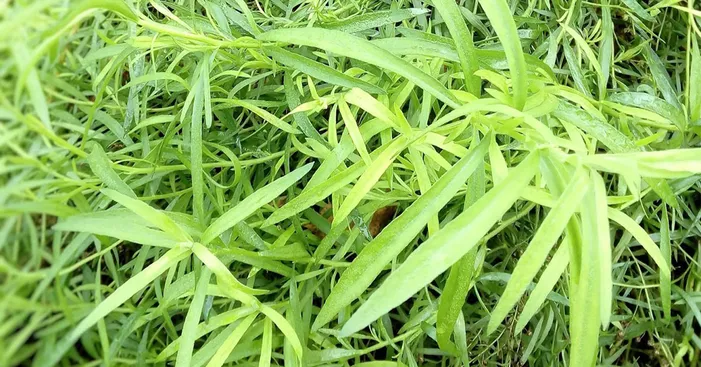
There is no way we can gather the entirety of tarragon’s health benefits however, we are going to show you the main ones.
For instance, this herb has great healing powers and great beneficial effects on blood vessels.
Good for the liver:
This herb offers choleretic effects thanks to more than 10 compounds including flavonoids, caffeic acid, coumarins…
Consuming tarragon stimulates the production of bile which promotes both a healthy liver and smooth digestion.
Not only that, but tarragon also contains herniarin which offers good protection from hepatitis.
Offers antibiotic properties:
Tarragon and other herbs have always been used to hide the unpleasant smell of rotten food.
Several centuries later, it was confirmed that tarragon contains substances that can fight the bacteria that cause food poisoning.
In fact, this aromatic herb offers more than 25 compounds that protect from bacteria including ocimene, coumarins, tannins, salicylic acids…
Thanks to these substances, tarragon has a powerful antibiotic effect and has long been used in traditional medicine.
A recent study confirms that tarragon oil extract can prevent the growth of many food-poisoning bacteria including E.coli.
A natural disinfector:
This is probably the most popular property of tarragon due to its ability to disinfect wounds.
In fact, even in Greek mythology, this herb was linked to the legend of Hippolytus who got swallowed by a dragon.
This is most likely the reason why the scientific name of this herb contains the word “dracunculus” which means “little dragon”.
Even in traditional medicines, tarragon was always used to treat snakebites and intestinal worm infections.
Natural blood thinner:
Tarragon contains a substance called “estragole” which offers anti-coagulant and anti-platelet effects.
These compounds work on breaking the built-up plaques in the walls of blood vessels formed by an accumulation of cholesterol.
As a result, the blood flow is smoother and the blood vessels are at a lower risk of thrombosis.
Many studies confirm the anti-platelet of tarragon and its ability to prevent cardiovascular disease.
The benefits for children:
Thanks to its restorative effect, tarragon offers many health benefits to children by activating their immune systems.
Mostly, the most important property that this plant offers to kids is that it improves digestion and appetite.
Once ingested, tarragon normalizes the child’s bowel movement and eliminates worms from his body.
The benefits for women:
In traditional medicine, tarragon infusion is a great remedy people use to reduce menstruation pain and shortens its length.
Also, thanks to its diuretic properties this plant can reduce the risk of bladder inflammation AKA cystitis.
In cosmetology, the minerals and vitamins in tarragon can eliminate wrinkles and improve skin elasticity.
Not only the skin, but tarragon is one of the natural ingredients many cosmetic companies use in their products.
The essential oil of this herb can cleanse the scalp of dandruff and dirt without drying it.
In addition, creams and facemasks made from tarragon can restore the skin and eliminate acne.
Finally, many studies confirm that tarragon extract can reduce the risk of breast cancer.
Benefits for men:
Most of this herb’s benefits come from its antioxidant and antibacterial effects which ensure that each body organ is functioning properly.
For instance, once a man ingests tarragon regularly it improves the functioning of the sex glands.
Also, it will offer good protection from infections that may affect the work of the genitourinary system.
Other health benefits:
- Relieves headaches.
- Prevents heart attacks and strokes.
- Improves the appetite.
- Helps with insomnia.
- Relieves anxiety and stress.
- Relieves intestinal problems.
- Stimulates liver function.
- Offers anti-microbial properties.
- Improves digestion.
- Lowers blood sugar levels.
- Maintains eye health.
- Stimulates kidney function.
- Relieves toothache.
Using tarragon:
Kitchen usage:
Generally, most types of herbs go well with eggs, seafood, and meat (especially chicken).
This also applies to tarragon!
Thanks to its unique strong and pleasant flavor, tarragon combines with vegetables, in soups and salads.
For instance, you can add fresh or dried tarragon to your fried eggs or omelets and it will make them refreshing.
Many people like to add it to creamy soups, potato dishes, fish, beef steak …
In case you are using ground tarragon to season fish or meat, make sure you are not putting too much on the outside skin.
This is because if you’re roasting or smoking the meat/fish with powdered tarragon it will burn fast and causes the fish skin to over-burn.
Therefore, when you’re seasoning fish or meat, always make sure you don’t insert the powdered externally but rather inside the sliced flesh.
Add fresh Tarragon or dried tarragon, especially to chicken meat, duck meat, tuna, Cod, and Salmon to enhance the flavor.
Some people like to juice fresh tarragon leaves with water to make a citrus-flavored green juice full of nutrients.
Traditional medicine usage:
Thanks to its abundance of minerals and vitamins, tarragon infusion can help cope with edema, scurvy, and infections.
In ancient Persia, people made tinctures using tarragon to treat toothache and menstruation pains.
Use tarragon to make a face mask by combining mashed tarragon with honey to obtain a paste that cleanses the skin.
In Tibet, this herb is used for its antioxidant effects to treat tuberculosis, bronchitis, and epilepsy.
Bearnaise sauce :

Ingredients:
- 2 tbsps of finely cut tarragon.
- 4 egg yolk.
- 2 chopped red onions.
- 5 tbsps of white vinegar (2.5 ounces).
- 1 tbsp of lemon juice.
- ½ lb of butter (225g).
- 1 tsp of salt
Preparation:
- In a frying pan, add the chopped tarragon with onion and vinegar and let them cook on medium heat until they boil.
- Drain the liquid in a glass and put the remaining herbs to the side.
- Now add the collected liquid sauce to a blender alongside egg yolks, salt, and lemon juice.
- Blend them for 2 minutes until you obtain a smoothie-like yellow mixture.
- In another pot, melt all of the butter and then start adding it to the blender.
- Blend again until you obtain a mayonnaise-like sauce.
- Serve the aromatic sauce with seafood, meat, and salads and it will elevate your recipes!
Precautions before you consume tarragon:

Despite all the health benefits of this amazing herb, it still has some possible side effects.
For instance, few studies on tarragon oil extract show potential carcinogenic effects.
Nonetheless, the results of these studies occurred with a high dosage of tarragon essential oils.
Since no one can ingest 10 vials of tarragon per day, moderate consumption has almost no possible harm.
However, tarragon oil extract burns the skin which is why we need to dilute it with another vegetable oil to use it on our skin.
Because of this, it is also not recommended to use tarragon essential oil on children under 3 years of age.
Here are the groups of people who need to pay attention before using tarragon:
- Allergic patients: Being a member of the Daisy family, some people could be allergic to tarragon.
- For instance, those who are allergic to sunflowers or sage must always stay away from the tarragon.
- Pregnant and breastfeeding women: this herb contains certain elements like “thujone” which may lead to miscarriages.
- People with gallstones: tarragon contains substances that encourage bile flow and mostly promote gallbladder contractions.
- As a result, the body has more chances to expel gallstones naturally but the process is really painful.
Buying tarragon:
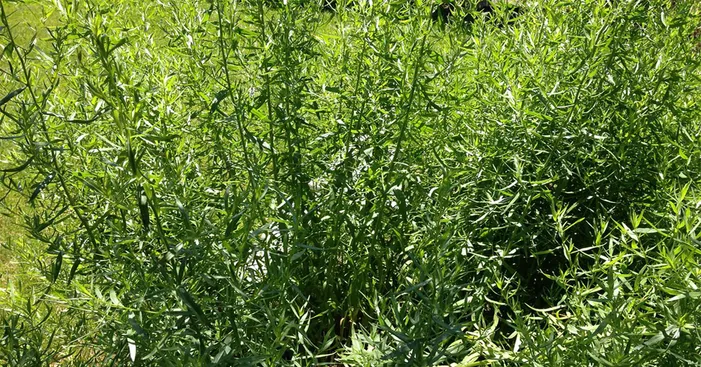
You can find tarragon in the market either fresh, dried, or ground into a fine powder.
To buy the best tarragon products there are a few tips you need to know:
Fresh tarragon: the leaves need to be bright green with little to no spots.
Dried tarragon: Should be kept in a well-sealed glass container in a cool place away from the light.
Ground tarragon: Must also be stored in an airtight glass container preferably dark.
Storing tarragon:
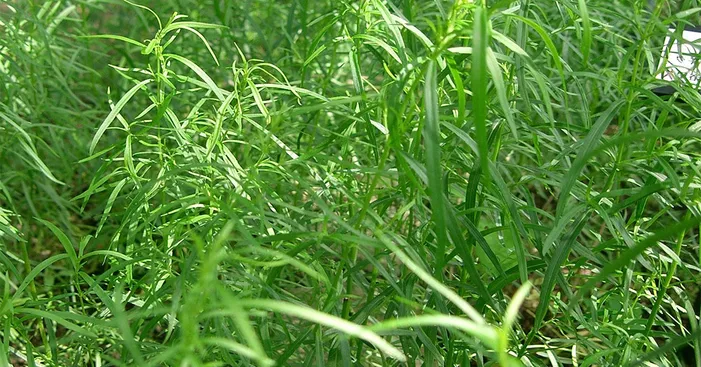
Storing fresh tarragon with salt:
- You can store fresh tarragon by using traditional pickling techniques.
- Start by washing your tarragon leaves and then drying them on a piece of cloth.
- Grind the fresh leaves with salt in a 5:1 ratio then put the mix into a well-sealed and in the fridge for up to 1 year.
Tarragon stored in oil:
- Another traditional way is by chopping it finely, putting it in a glass jar then pouring vegetable oil until the herb is covered.
- Add a pinch of salt and make sure the jar is well-sealed before you place it in a cool place for up to 1 year.
Like most herbs, you can also freeze fresh tarragon leaves (for up to 1 year) the texture will not be the same after you freeze it.
However, if you want to do that make sure you wash it properly then wrap it with plastic foil and freeze it.
Finally, you can also dry tarragon leaves in a cool place away from the sun and then store them in a glass jar for 1 year.
